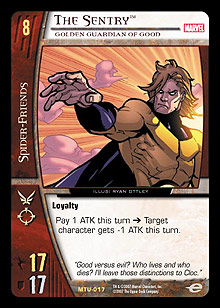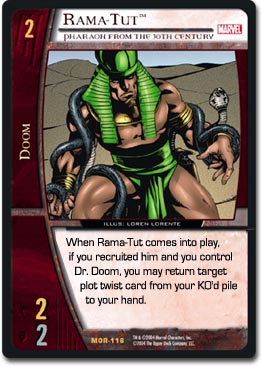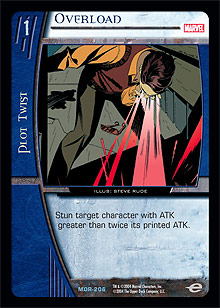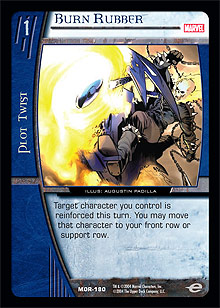
|
The Sentry™
Card# MTU-017


While his stats aren’t much bigger than those of the average 7-drop, Sentry’s “Pay ATK” power can drastically hinder an opponent’s attacking options in the late game.
Click here for more
|
|
|

|
|
|

 |
 |
|
|
| |
I believe that some of the more interesting articles to revisit are those where there is a heated issue with an accompanying policy change. When such announcements are released, there tend to be polarized opinions and predictions about the impact of those changes. As such, I would encourage people to take a look back at how we handled the Overload and Rama-Tut issues in the middle of the year. In light of tournaments and your own gaming experiences in the past six months, what do you think of our decisions? Have your opinions changed? Do you miss the original functionality of these cards? What do you think our game would look like now without these changes?
Comments welcome at DHumpherys@metagame.com.
The Dr. Light, Master of Holograms / Rama-Tut Combo Deck
First off, we had to decide how we felt about the existence of this deck. While it can be attacked in a number of ways and can be defeated by a deck with the appropriate tools a decent percentage of the time, the fact of the matter is that there are still very few ways to stop it. The deck wins consistently on turn 4 and occasionally on turn 3, which is much sooner than we’d want to see, given the range of answers and variety of decks we’d like to show up in a healthy metagame. Furthermore, the deck is still very robust against many answers, as witnessed by its victory in a second straight $10K even when players were able to metagame against it. Ultimately, we feel that the deck would stifle the long-term health of the metagame, and this is the viewpoint of the majority of the public as well. We are not opposed to having combo decks in our metagame, and in fact, we believe that they can bring a lot to our game. However, we believe this particular deck is too fast and too robust. Having made this decision, it became a question of how we would remove it from the metagame.
While we try to avoid functional errata to cards that have been played a reasonable amount, we could still make a relatively straightforward fix to Rama-Tut. Since all of the cards in the deck in question have already seen competitive play, we believed it was logical to errata an older card rather than a newer one, which would likely see more play via Modern Age or Sealed Pack play. The new wording of Rama-Tut is:
 “When Rama-Tut comes into play, if you recruited him and you control Dr. Doom, you may return target plot twist card from your KO'd pile to your hand.”
This option still leaves the card working very similarly to its printed version and original intent.
Rama-Tut is a card that would have continued to impose design constraints on us if we didn’t give it erratum, and yet, I still believe he will see some action in the future, even with this wording.
As we made this change, we also considered all other cards that have come into play effects. Kyle Rayner, Last Green Lantern could lead to similar problems if we aren’t careful with what Constructs we make, but we’ve decided this is a design constraint under which we are willing to work. We even considered errata to Dr. Doom, Diabolic Genius, since he could theoretically set up a loop some day if we aren’t careful. Again, this is something we should have no problem working around. Besides loops, we took a careful look at power level on these types of cards, and while there are some powerful effects, nothing struck us as needing errata.
In this particular case, while there may be some powerful decks that can still be built around Devil’s Due and readying Dr. Light, Master of Holograms a few times in a turn, nothing too crazy can be pulled off. As best as we can tell, we can fix the situation with a fairly innocuous erratum on a single card that has only recently seen play.
Before There Was Rama-Tut Recursion: The SNO Debate
 The Rama-Tut erratum addresses the hottest issue out there in the community right now; however, it wasn’t long ago that there was another issue almost as fiercely debated. Specifically, there was concern that players were enhancing the ATK of their opponents’ characters only to Overload them. This interaction was exploited most prominently by Curve Sentinel decks, which made up a whopping 42% of the field in the most recent Pro Circuit. While some relatively non-combative decks gave Curve Sentinels a run for its money, for the most part, other decks focusing on combat struggled against it. Curve Sentinels outshone the rest of the field. Its representation in the top of the standings at the end of Day 1 was in even greater proportion than would be expected from its already abundant numbers.
Even prior to this event, the “SNO” interaction—so named for the most prominent cards of interest, Savage Beatdown, Nasty Surprise and Overload—was creating much consternation in the community. Public opinion seemed very much in favor of a change. Not the only key to the success of Curve Sentinels, this interaction was an integral part in its becoming the overwhelming “Deck to Beat” in recent tournaments.
Why Errata Wasn’t So Easy in This Case
In dealing with this situation, we’ve chosen a solution that was more dramatic than the community might have expected. I’d imagine many people believed we would errata Savage Beatdown, Nasty Surprise, and possibly a few other cards, such as Flying Kick, to only affect characters that “you control.” In fact, the Flying Kick in the Fantastic Four Starters uses this language. Many people viewed this as an indicator that we were going to address the situation, but believe it or not, that was just a misprint.
The primary obstacle in tackling the “SNO” interaction by errata is in assuming that it is just a problem with a select few cards. Where do we draw the line on the errata, and how are players supposed to easily know which cards have received errata? Some of the central issues in the debate included the following:
1. Do we just errata cards the cards that give +5 ATK or more? +3 ATK or more? And what about cards like Bastion, or other variable and team stamped cards like Strength from the Grave? What happens when people then start playing cards just under the threshold we select, and those actually start causing problems again?
2. We could errata all cards that give an entirely beneficial effect to only modify characters you control. It just so happens, though, that such a change would affect dozens and dozens of cards. There are also cards that fall into gray areas, like Shadow Step and Overexposed, where they were clearly intended to be playable on opposing characters. Should we errata those cards so that they can’t target opposing characters? Or so that only characters you control would get the stat bonus? Or not errata them at all?
3. We could use our judgment to choose cards on a case-by-case basis that we think could possibly be problematic. But then how’s a player supposed to know whether or not the card he or she is playing with or against has received errata?
4. In terms of open-ended game play, shouldn’t you be able to modify an opposing character’s stats so long as it is something we think is balanced and interesting? This issue carries over to non-stat modifiers as well. Should Dick Grayson, Defender of Blüdhaven only be able to reinforce characters you control? After all, with Azrael, Jean Paul Valley, he can reinforce opposing characters to help KO them. Thematic arguments aside, it seems like these sorts of interactions are perfectly acceptable and even interesting if they are appropriately balanced.
While we were sorting out these issues, at some point, we had to ask if the real “problem” might be with Overload itself! All of these changes were being considered to preserve one card in a card pool. We prided ourselves on not having a single banned card, but we couldn’t let that stand in the way of our decisions. Aside from Overload, there are no other reasons that pumping your opponent’s characters is particularly imbalanced. But is Overload a fair and desirable card to have in our game?
Let’s take a look at what the intent was in including Overload in the Marvel Origins set. Since most of our plot twists did not have an “actual” cost (some have additional costs), but instead simply a threshold, there were many concerns at that time players would be able to easily toss all their eggs in one basket and deal whopping blows to an opponent without fear of repercussion. We were also concerned that it would be far too easy for characters to attack up the curve with cards like Savage Beatdown when we’d rather encourage things like team attacks. The meaningfulness of playing larger characters might be lost. The rationale behind these arguments still applies. However, we believe that we have may have overestimated our concerns on some of these issues, and there are now many more cards in the card pool that can be selected by a player concerned with some of these scenarios.
Combating the Big Blow
 Can our game handle a player who is throwing all of his or her combat modifiers on a single character at a crucial point in the game? Unless you are being attacked directly, there are many options to combat what would be a devastating blow. A player can soften the blow of such an attack with a card like Burn Rubber, Fast Getaway, or Swift Escape. There are also plenty of good options in team-stamped cards like Heroic Sacrifice or Escape Artist. These are certainly less swingy effects than stunning an attacker and getting to swing back yourself, as was frequently the case with Overload—and was that really a fair punishment to the attacking player?
Rampant Attacking up the Curve?
Will off-curve decks be too powerful when they can attack or defend up the curve without fear? Well, thus far, combat-oriented off-curve decks have yet to make much of an impact on the metagame. Even The New Brotherhood decks, for the most part, have played on the curve at least through turn 5. We believe that banning Overload will help get off-curve decks into the spotlight. They can use combat modifiers without almost automatically being put into Overload range. They still have to deal with all of the checks imposed by cards like Flame Trap, Total Anarchy, Reign of Terror, and characters that can stun down the curve, like Terra, Robot Destroyer, and Gambit. So in terms of concerns about the game being able to handle over-zealous small characters, we should still be fine.
Additional Issues with Overload
Limitations on Our Design
Overload has been especially problematic in just how severely it punished characters that naturally pump their own ATK. Take, for example, Pantha! Is it so wrong for Pantha to merely attack that she should be subject to getting stunned by Overload? And what of Killer Croc? Should he have no other room to augment his stats other than by the game text we’ve given him? Any guesses why Elektra, Assassin has her first power?
Too Much Additional Math
There’s a lot of math in our game, and I don’t know too many people who enjoyed having to worry constantly about what double each of their characters’ ATK value was. You really couldn’t ever take the risk that your opponent might have an Overload in hand. Besides worrying about this each turn, you also had to spend time figuring out how to best divide up your combat modifiers over a number of turns. Yes, this was challenging and would reward a good player, but wasn’t this really too much thought revolving around a single card and element in the game? Lack of Team-Stamping
Overload is a generic card, and we’d much rather ban a generic card that may become a fixture in every deck than ban a team-stamped card that can’t really see too much play unless the metagame is heavily skewed towards that team.
The net result of all of this was to ban Overload from organized play in Constructed events. I don’t think the card will be missed for long, and I believe the banning will do a lot to improve the metagame from where it stood at the last Pro Circuit. Curve Sentinels will still be very strong, but this should open the doors to competition, both new and old. While we believe the existing card pool provides more than enough tools to alleviate the need for Overload in the environment, there are still merits to the original intent of the card, and we may still print more balanced forms of the card in the future.
The Next Few Weeks, and the More Distant Future
These changes will take effect July 1. While I believe these changes will improve the game significantly in the long run, I still believe that the metagame for the rest of the month looks far from horrendous, given the range of viable decks. While Rama-Tut Recursion has won the past two $10Ks, there has been a lot of variety in terms of decks doing well. I won’t linger on this, but someday, you might wish you’d taken a shot at beating this deck or even playing it yourself. We’ve made changes to fix some of the gameplay dynamics we felt were necessary and that our player base felt strongly about, but I hope in the meantime you’ll make the most of what remains of this fresh metagame period.
Also, players who have received foil extended art Overloads as PCQ prizes will have the option to exchange those cards for foil extended art copies of Teen Titans Go! at all $10K Championships and Pro Circuit events starting at Origins on July 1. PCQs will award copies of Teen Titans Go! to the top finishers through Gen Con Indy.
|
| |
| Top of Page |
|
 |
|
|
 |